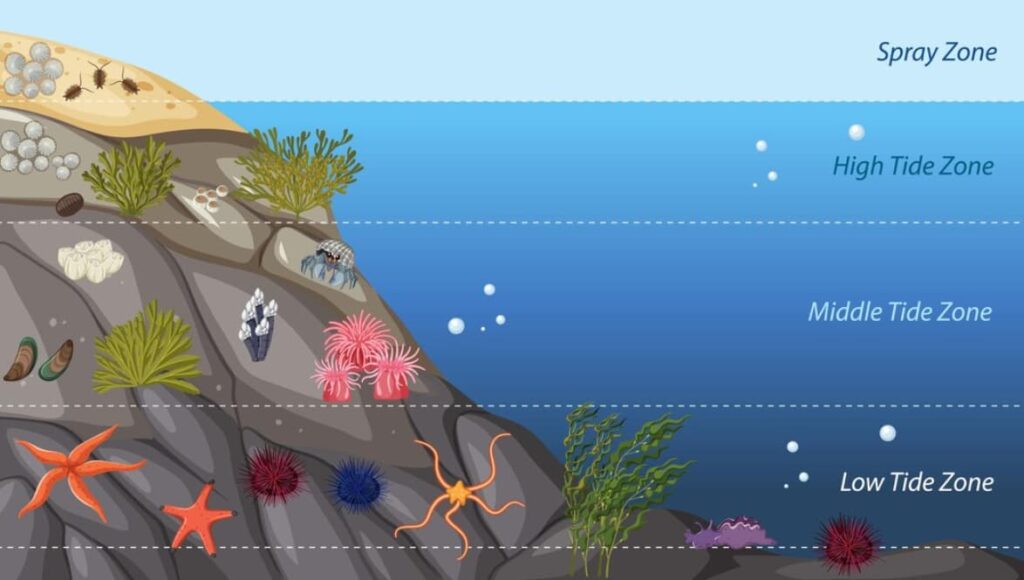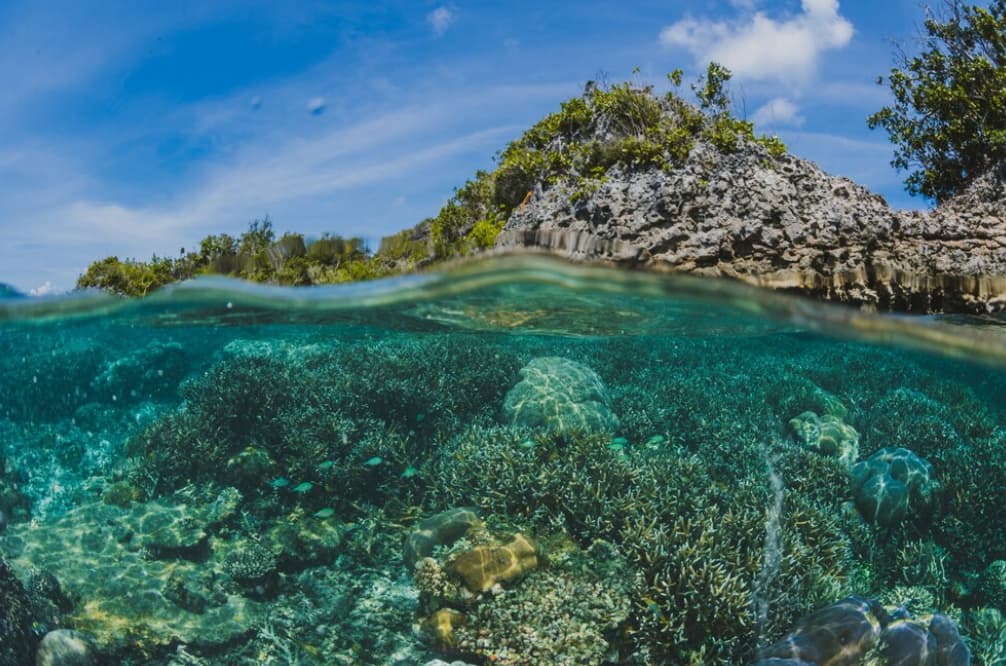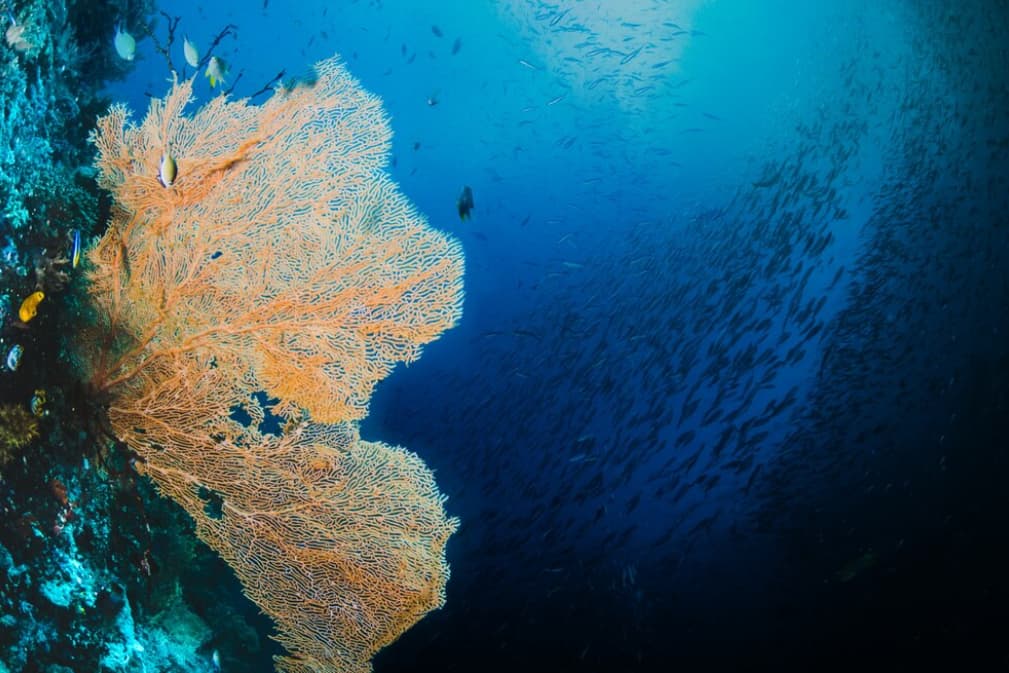The ocean, with its vastness and depth, remains a mystery to most, inviting exploration through its diverse zones. Delving into these zones helps us unravel the secrets of the 70% of our planet covered by water.
For adventurers, scientists, and dreamers alike, the ocean has always been a source of wonder and intrigue. Spanning 70% of the Earth’s surface, it holds countless marvels awaiting discovery as we venture into its varied realms.
From the dynamic intertidal zone, where land meets sea, to the profound darkness of the oceanic zone’s depths, each region offers distinct features, inhabitants, and seabed landscapes.
The Intertidal Zone
Nestled at the juncture of land and sea lies the intertidal zone, a dynamic habitat subjected to the ebb and flow of tides. Stretching along coastlines, this ever-shifting zone spans the area between high and low tide marks.
Life in the intertidal zone has evolved remarkable adaptations to thrive in both aquatic and terrestrial conditions, making it a fascinating realm of ecological diversity. From rugged rocky shores to sandy beaches, this environment is characterized by its harsh conditions yet teems with a plethora of life forms.
Within this zone, a myriad of organisms such as sea stars, snails, seaweed, crabs, barnacles, mussels, and kelps flourish, often inhabiting shallow rock pools left behind by receding tides. The intertidal zone is further delineated into high tide, low tide, and middle tide regions, each hosting its own unique array of life forms adapted to the challenges of their respective zones.
The Neritic Zone
| Depth Range | 0-200 meters (0 – 656 feet) |
| Location | From the shore to the continental shelf |
| Encompassed Zones | Epipelagic |
Stretching from the water’s edge along the shoreline to the edge of the continental shelf lies the vibrant habitat known as the neritic zone, also known as the sublittoral zone. Situated within depths of 0 to 200 meters (0 to 656 feet), this coastal oceanic realm teems with life and is bathed in sunlight, thanks to its shallow nature.
The neritic zone’s proximity to the coastline allows ample sunlight to penetrate its waters, fostering photosynthesis and supporting a rich biodiversity, often dominated by thriving coral reefs. This abundance of sunlight and nutrients sustains a diverse ecosystem, making the neritic zone a vital area for marine life.
Defined by its shallow depths over the continental shelf, the neritic zone overlaps with the epipelagic zone, which is delineated by the penetration of sunlight. This overlap occurs because in many regions, the continental shelf coincides with areas where sunlight reaches depths sufficient for photosynthesis. Despite this overlap, the neritic and epipelagic zones are distinct, each defined by its own criteria—depth over the continental shelf for the neritic zone and sunlight penetration for the epipelagic zone.
The Epipelagic Zone
- Known colloquially as the sunlight zone, the epipelagic zone encompasses the entirety of the Neritic zone, extending from 0 to 200 meters deep (0 to 656 feet);
- This region boasts approximately 25% of the ocean’s biodiversity and is also referred to as the euphotic zone, characterized by its ample sunlight penetration, crucial for photosynthesis to occur.
The abundance of sunlight and warmth from the sun fosters robust plant and animal life within this zone. From minuscule phytoplankton to majestic predators like sea turtles, sharks, and whales, a diverse array of marine creatures thrives here.
Not only does the epipelagic zone provide a permanent habitat for numerous sea creatures, but it also serves as a vital nursery for the maturation of young oceanic species and a secure environment for mature adults to engage in reproduction.
Life in the Epipelagic Zone
The Epipelagic Zone, renowned for its exceptional biodiversity, harbors approximately 70% of the ocean’s diverse life forms, primarily owing to the ample light that penetrates its depths.
The presence of sunlight fuels the proliferation of photosynthesizing microorganisms, particularly phytoplankton, which serve as the foundational elements of marine ecosystems.
In addition to phytoplankton, the Epipelagic Zone is adorned with a plethora of larger flora such as seagrass, algae, mangroves, and kelp, alongside reef-building corals that provide essential habitats for juveniles and smaller species.
Among the diverse array of inhabitants in this zone are reef-dwelling organisms like clownfish, anemones, crustaceans, and various invertebrates, while larger marine species like whales are often spotted feeding on plankton within its expanses.
Moreover, the Epipelagic Zone serves as a sanctuary for breeding and nursery grounds for larger fish species such as sharks and tuna, adding to its significance in sustaining oceanic life.
Undoubtedly, the Epipelagic Zone stands as the pinnacle of life abundance within the oceanic realm.

The Oceanic Zone
| Depth Range | 200-10,935 meters (656-35,900 feet) |
| Location | From the continental shelf to the open ocean |
| Encompassed Zones | Mesopelagic, Bathypelagic, Abyssopelagic, Hadalpelagic |
As the neritic zone transitions into the continental shelf, a dramatic descent unfolds, marking the inception of the oceanic zone that stretches into the vast expanse of the open ocean.
While some regions of the oceanic zone may overlap with the epipelagic zone, the further we venture into its depths, the dimmer the light becomes, gradually diminishing the abundance of life.
Encompassing depths ranging from 200 meters to the staggering depths of 10,935 meters (the deepest point in the ocean), the oceanic zone comprises several distinct regions: the mesopelagic, bathypelagic, abyssopelagic, and hadalpelagic zones. Each of these zones is characterized by variations in depth, light availability, temperature, and the diversity of marine life, contributing to the enigmatic nature of the ocean’s depths.
Mesopelagic Zone
- Diving into depths ranging from 200 to 1,000 meters (656-3,280 feet), the mesopelagic zone beckons adventurers into a realm where sunlight begins to wane, casting the surroundings into a dim twilight;
- Within this mysterious zone, an array of deep-sea inhabitants, including lanternfish, bristle-mouthed fish, squid, and jellyfish, thrive with specialized adaptations tailored to survive in the dimly lit environment;
- Many species rely on specialized eyesight and bioluminescence for navigation and hunting in the absence of abundant sunlight.
Central to the mesopelagic zone is the thermocline, a transition layer where water temperature rapidly decreases due to the combined effects of increasing pressure and diminishing sunlight. This dynamic interplay between the thermocline and shifting light levels results in constant temperature fluctuations, contributing to the zone’s alternate designation as the “middle zone.”
Life in the Mesopelagic Depths
Delving deeper into the ocean, life encounters increasingly challenging conditions. The scarcity of sunlight, essential for photosynthesis, coupled with plummeting water temperatures, contributes to the sparsity of life forms in the mesopelagic zone.
However, despite the stark environment, the mesopelagic zone is not devoid of life. Certain species of zooplankton persist in these depths, forming the foundation of the food chain for smaller fish, jellyfish, and shrimp. These smaller organisms, in turn, become prey for larger predators like eels or swordfish, sustaining a delicate ecosystem in this dimly lit realm.
Due to the absence of sunlight, photosynthesis cannot occur in this zone, resulting in the absence of flora or reef-building coral that typically rely on light for sustenance and growth. Yet, despite the challenges posed by darkness and cold, life finds a way to adapt and thrive in the mesopelagic depths.
Bathypelagic Zone
- Descending further into the ocean’s abyss, we encounter a realm where light vanishes entirely, plunging us into an eerie darkness;
- The bathypelagic zone, spanning depths from 1,000 to 4,000 meters (3,280-13,123 feet), earns its moniker as the “midnight zone” due to the absence of sunlight penetration.
In this lightless expanse, the only illumination emanates from the bioluminescent organisms that have adapted to survive in such extreme conditions.
Unlike the mesopelagic zone, where temperature fluctuations occur, the bathypelagic zone maintains a constant near-freezing temperature of around 39°F (4°C).
The pressure exerted by the immense water column above is staggering, reaching over 5850 pounds per square inch at these depths.
Despite the frigid temperatures and crushing pressure, formidable creatures like sperm whales brave the depths of the bathypelagic zone in search of sustenance, demonstrating the resilience and adaptability of life in the ocean’s deepest reaches.
Life in the Bathypelagic Zone
In the depths of the bathypelagic zone, vegetation is absent, with not even a trace of phytoplankton. Devoid of light, organisms reliant on photosynthesis cannot thrive in this lightless realm.
Nevertheless, despite the darkness and freezing temperatures, life persists in these abyssal depths.
Carnivorous predators such as sharks, squid, and octopuses populate the bathypelagic zone, scavenging on carcasses that descend from the zones above.
Many inhabitants of these depths possess soft, translucent skin that adapts to withstand the immense pressure exerted by the surrounding water.
While few mammals venture to such depths, sperm whales are occasional visitors, equipped with large, pressure-resistant heads that aid them in hunting squid. However, as mammals, sperm whales are not permanent denizens of the zone and must periodically return to the surface for warmth and oxygen.
Abyssopelagic Zone
- Beneath the bathypelagic zone lies the abyssopelagic zone, spanning from 4,000 to 6,000 meters (13,123-19,685 feet) and harboring some of the planet’s most extraordinary creatures;
- In the profound darkness of the abyssopelagic zone, organisms like the ethereal gulper eel and the mysterious tripod fish have evolved unique adaptations to hunt and survive amidst constant darkness, freezing temperatures, and extreme pressure.
Covering three-quarters of the deep-ocean floor, the abyssopelagic zone derives its name from the Greek word meaning “no bottom,” reflecting the perception of the ocean’s seemingly boundless depth.
Life in the Abyssopelagic Zone
As we descend into the abyssopelagic zone, life becomes exceedingly sparse.
Giant squid, dragonfish, tubeworms, and various invertebrates, including sea spiders, drift or slowly move through this realm, perpetually searching for sustenance.
While larger marine creatures are rare at these depths, some shark species, such as the cookie-cutter shark and the frilled shark, are known to inhabit this unique habitat.

Hadalpelagic Zone
- The Hadalpelagic zone plumbs the unfathomable depths of the ocean, extending from 6,000 meters down to the seabed, where the Mariana Trench harbors the deepest point on Earth, reaching 10,994 meters (36,070 feet).
Despite the relentless cold and crushing pressure that characterize this abyss, life persists in surprising forms. Even in the Challenger Deep, the deepest part of the Mariana Trench, single-celled organisms known as foraminifera, a type of plankton, have been discovered.
Occasionally, fish have been observed in some of the ocean’s deepest recesses, descending to depths exceeding 8,000 meters, notably in the Puerto Rico Trench.
Benthic Zone
The benthic zone encompasses the ocean’s seafloor, extending from the shallows of the intertidal zone to the deepest reaches of the Oceanic Zone.
Comprising diverse underwater landscapes such as continental slopes, shelves, abyssal plains, trenches, volcanic islands, and seamounts, the benthic zone presents a mosaic of habitats and ecosystems.
As the benthic zone traverses all other oceanic zones, the environmental conditions—including light availability, pressure, and life forms—vary dramatically according to location and depth, reflecting the dynamic nature of the ocean’s underbelly.
Frequently Asked Questions
Organisms in the mesopelagic zone have evolved various adaptations to cope with minimal light. Common adaptations include bioluminescence and large eyes with specialized features, which aid navigation in the dimly lit environment of the Twilight Zone.
Coral reefs thrive in the neritic zone due to optimal conditions such as ample sunlight and stable temperatures. These conditions are essential for the photosynthesis of the coral’s symbiotic algae, which forms the foundation of coral reef ecosystems.
The ebb and flow of tides within the intertidal zone are primarily driven by the gravitational interaction between the moon and Earth’s oceans. As the moon orbits Earth, its gravitational force creates bulges on the ocean’s surface, resulting in the periodic rise and fall of tides.
Human activities can significantly impact various oceanic zones. For instance, deep-sea mining operations can disturb fragile ecosystems in the abyssal and hadal zones, while overfishing in the neritic zone can disrupt marine food chains. Furthermore, pollution, including plastic waste and chemical runoff, poses a significant threat to marine life across all zones, leading to habitat degradation and ecosystem disruption.
Conclusion
The intricate layers of our planet’s oceans, from the vibrant biodiversity in sunlit zones to the mysterious, unexplored depths, are a testament to the wondrous complexity of Earth. Each oceanic zone serves as a distinct testament to the rich, diverse life that exists beneath the ocean’s surface.



